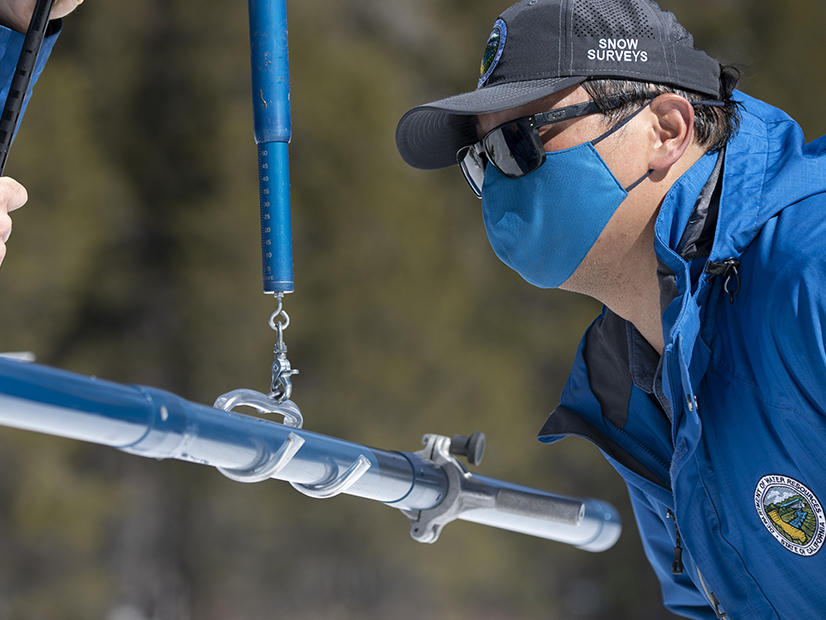
California should expect a third year of drought after two nearly rainless winter months, the state Department of Water Resources (DWR) said following its latest survey of Sierra Nevada snowpack.
Low reservoir levels will limit hydropower generation this summer, and extremely dry conditions could worsen wildfires, which burned close to 7 million acres in the past two fire seasons combined.
“With only one month left in California’s wet season and no major storms in the forecast, Californians should plan for a third year of drought conditions,” DWR Director Karla Nemeth said in a statement last week. “A significantly below-average snowpack combined with already low reservoir levels make it critical that all Californians step up and conserve water every day to help the state meet the challenges of severe drought.”
The third snow survey of the season — conducted at Phillips Station, an alpine meadow near Lake Tahoe — showed snowpack there was 68% of average for March 1. Statewide, the snowpack was 63% of average for the date, the department said.
Heavy rains throughout the state in December had raised hopes of avoiding a third consecutive dry year. The snowpack on Jan. 1 at Phillips Station was 202% of average, and statewide snowpack was 154% of average. But an absence of new precipitation combined with early season snowmelt made those figures plumet.
“As the world continues to warm, precipitation is pushing toward extremes,” Jeremy Hill, manager of DWR’s Hydrology and Flood Operations Branch, said in the statement. “Even when we see large storms producing a lot of snow early in the season, all it takes is a few dry weeks to put us below average.”
The agency said the snowpack would not be enough to fill the state’s reservoirs, which supply water for residential and agricultural use during California’s dry months and generate thousands of megawatts of electricity to help meet summer peak demand.
DWR’s State Water Project is the fourth largest power producer in California; hydroelectric generation historically supplies about 14% of peak summer capacity.
The state’s two largest hydropower-producing reservoirs were below half-full on Sunday. Lake Shasta stood at 37% of capacity and Lake Oroville at 46%. In an average year, Lake Shasta would be about twice as full by now, and Lake Oroville would have 28% more water.
The power plant at Lake Shasta, operated by the U.S. Bureau of Reclamation, has a nameplate capacity of about 700 MW, though actual production has diminished significantly over the past two years.
DWR’s 644-MW Edward C. Hyatt Powerplant at Oroville Dam has fared even worse. It shut down for the first time in its history on Aug. 5 because the lake had dropped to critically low levels. After the December storms, the plant restarted one generating unit to supply electricity to CAISO’s grid.
A two-decade drought in the Southwest has strained Colorado River supplies, with Lake Mead behind Hoover Dam and Lake Powell behind Glen Canyon Dam dropping so low that hydropower generation could cease. (See Western ‘Megadrought’ Curtails Hydropower and Western Drought Puts Hoover Dam Hydropower at Risk.)
In 2020 and 2021, California saw two of its driest years ever. Snow water content in California peaked at 60% of normal in 2021 after a similarly dry winter the year before, CAISO said. The ongoing drought reduced hydropower by 1,000 MW in 2021, the California Public Utilities Commission and California Energy Commission said last summer.
Since the rolling blackouts of summer 2020, CAISO and the CPUC have been working to install batteries to store solar power for summer evening peak hours. More than 2,000 MW of battery capacity were added by the end of 2021 with another 2,000 MW expected to come online this year, the ISO said.

